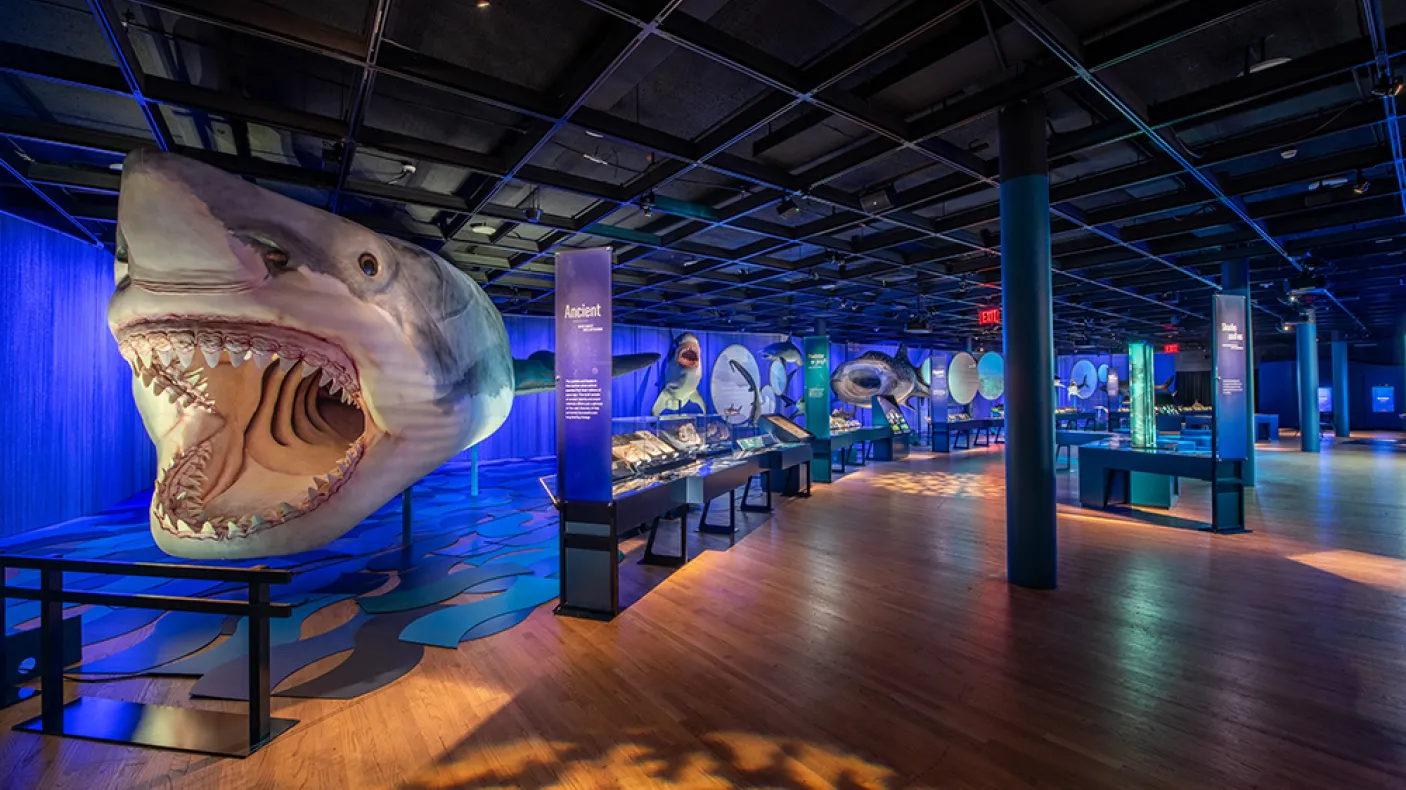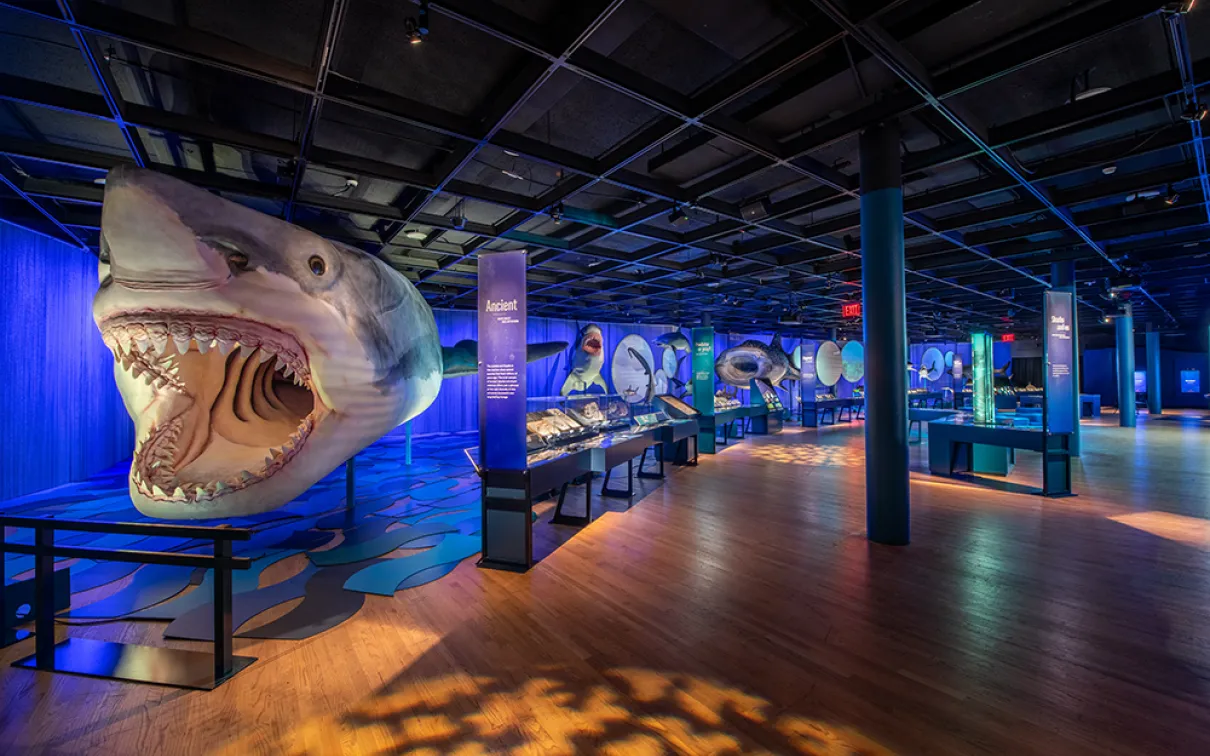Sink your teeth into the thrilling world of Sharks at ROM this fall
Published
Category
Sink your teeth into the thrilling world of Sharks at ROM this fall
TORONTO, July 10, 2025 – Cue the Jaws theme song – and get ready to get up close and personal with the creatures pop culture has presented as ruthless, sharp-toothed monsters of the deep seas – a misconception that still haunts moviegoers’ dreams until today.
But don’t be scared – even the most timid of visitors will find plenty to enjoy in the upcoming exhibition Sharks, presented by Desjardins Financial Group and organized by the American Museum of Natural History in New York, opening at the Royal Ontario Museum (ROM) on October 11, 2025, and running until March 22, 2026.
Visitors will learn all about these astonishing animals (including their surprising abilities, hundreds of species, prehistoric origins, and much more), and maybe even come to understand that sharks are a little less dangerous than we fear – and a whole lot more interesting!
“Sharks captures the rich complexity of creatures that have long fascinated humankind – and which now face urgent threats to their survival,” says Josh Basseches, ROM Director & CEO. “With an enthralling mix of immersive interactives and mounted models – including a gigantic megalodon – this exhibition is sure to captivate families and visitors of all ages.”
Few animals have captured the human imagination quite like sharks – permeating pop culture through Hollywood films and must-see media events like Discovery’s Shark Week – inspiring our awe over the endurance, adaptability, and elite predator status of the vast array of sharks that inhabit the waters.
Our fascination with sharks is understandable, given that they’ve been around even before the dinosaurs – scientists trace their evolutionary path back to more than 450 million years ago. Today, there are more than 560 species of sharks and over 740 species of their closest relatives – rays, skates, and chimaeras – inhabiting nearly all the world’s marine environments, from coral reefs to the polar seas, and even freshwater rivers.
Sharks is a deep dive into the world of these (sometimes) fearsome fishes, taking visitors through the incredible diversity of the species via spectacular large-scale models, fossils, and interactive installations.
“We’re very excited to continue our partnership with ROM. The museum is a cultural landmark with an undeniable track record of staging immersive exhibitions across different media for adults and kids alike. Sharks provides an opportunity for visitors to learn about an animal that fascinates so many of us, while also getting an important educational component on biodiversity and the state of our oceans and the planet,” says Isabelle Garon, Executive Vice-President, Marketing, Communications, Cooperation & President’s Office, Desjardins Financial Group.
Upon entering the exhibition, the gaping jaws of an ancient megalodon – the largest predatory fish of all time, which lived in the seas 10 million years ago – underscores the enduring dominance of these wonders of the waters. With its open mouth and gargantuan teeth, this gigantic replica opens a spectacular display of 30 life-sized models representing the astounding breadth of shark species – such as great white, bull, frilled, and Greenland sharks.
Visitors will be amazed by some of the world’s most unique and unusual sharks – did you know hammerhead sharks’ distinctive head shape gives them the ability to detect electromagnetic fields, while their distant relatives the lantern shark are bioluminescent and glow underwater?
And despite common misconception, they’re not all massive beasts – Sharks presents the entire spectrum, from the huge-but-gentle whale shark to the tiny dwarf lantern shark and aptly named pocket shark, a pair of species small enough to be held in one hand.
Visitors will dive into engaging interactive elements, such as a challenge to hunt like a hammerhead, or a pattern-matching game that reveals how the unique spots on whale sharks can be used like fingerprints to identify individual fish. Discover the specialized adaptations that help sharks succeed in their environments, and marvel at a giant room-sized projection that displays the diversity of sharks that can be found in ocean habitats today.
While we might typically think of sharks as hunting in far-off seas, sharks can be found off Canada’s coastlines. Greenland sharks have been known to live in the cold, brackish waters of the St. Lawrence River estuary and Ontario’s northern seas off Hudson Bay and James Bay, and the iconic great white shark has been recently documented on both coasts of Canada in Nova Scotia and British Columbia.
Sharks also serve as a harbinger of the health of our environment. By encouraging a better understanding of these magnificent creatures, along with their habitats and the many threats they face amid climate change and other impacts on our marine ecosystems, the exhibition reminds us that sharks are much more than their feared persona – and are in fact a critically important group of animals we share this Earth with.
“As powerful predators and super-sensitive scavengers, sharks play a critical role in regulating abundant prey populations throughout the world’s oceans,” says Dr. Nathan Lujan, ROM Associate Curator of Fishes. “They’re also remarkably diverse, with 450 million years of independent evolutionary history producing a host of distinctive specializations whose many benefits to mankind – from cancer treatments to aircraft aerodynamics – science is just beginning to uncover.”
While the image might come to mind of beachgoers dashing from the surf to the safety of shore upon sight of a slow-moving fin above the waves, humans in fact pose the far greater threat to sharks – millions are killed each year caught up in commercial fishing nets as bycatch, or through the practice of harvesting fins.
Sharks calls attention to the global need to protect the species – and showcases the many reasons why this ancient branch of fishes continues to loom large in our collective consciousness today.
ROM Members will have the first opportunity to attend Sharks during the Member Previews on Friday, October 10, and Saturday, October 11.
Sharks is organized by the American Museum of Natural History, New York (amnh.org). The Museum gratefully acknowledges Warner Bros. Discovery for its generous support of Sharks. A selection of footage in Sharks has been provided by Discovery's Shark Week.
Image credit: Megalodon, D. Finnin/© AMNH
-30-
ABOUT ROM
Opened in 1914, ROM (Royal Ontario Museum) showcases art, culture, and nature from around the world and across the ages. Today, ROM houses more than 18 million objects, from Egyptian mummies to contemporary sculpture, from meteorites to dinosaurs. ROM is the most visited museum in the country and one of the top ten museums in North America. It is also the country’s preeminent field research institute, with a diverse range of experts who help us understand the past, make sense of the present, and shape a shared future. Just as impressive is ROM’s facility—a striking combination of heritage architecture and contemporary, cutting-edge design, which marks the Museum as an iconic landmark and global cultural destination.
We live on in what we leave behind.
ABOUT THE AMERICAN MUSEUM OF NATURAL HISTORY (AMNH)
The American Museum of Natural History, founded in 1869 with a dual mission of scientific research and science education, is one of the world’s preeminent scientific, educational, and cultural institutions. The Museum encompasses more than 40 permanent exhibition halls, galleries for temporary exhibitions, the Rose Center for Earth and Space including the Hayden Planetarium, and the Richard Gilder Center for Science, Education, and Innovation. The Museum’s scientists draw on a world-class permanent collection of more than 30 million specimens and artifacts, some of which are billions of years old, and on one of the largest natural history libraries in the world. Through its Richard Gilder Graduate School, the Museum offers two of the only free-standing, degree-granting programs of their kind at any museum in the U.S.: the Ph.D. program in Comparative Biology and the Master of Arts in Teaching (MAT) Earth Science residency program. Visit amnh.org for more information.


